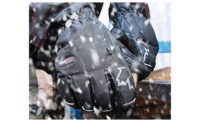Injuries to the hands and fingers accounted for 12.5 percent of incidents that caused workers to lose time away from work in 2009.1 Without proper glove protection, exposed workers are left to suffer thermal discomfort, increased strain and even tissue damage from frostbite. The technology behind work gloves has continued to advance as has the need for stronger more durable gloves that can protect workers from the toughest environments. However, not all gloves are created equal.
Effective insulation
To keep hands dry and safe from the elements, cold weather work gloves utilize insulation and waterproofing (WP) technology. Insulation works by trapping cold air between the outside of the glove-wearers hand. Low-quality insulations use thicker, bulkier fibers that do not trap air as effectively as others. In premium insulation, finer microfibers trap more air in a given space which allows the glove to perform better than those made from thicker fibers.
Insulation weight is also a key factor in cold weather work gloves. It doesn’t take a rocket scientist to determine that more insulation equals more warmth. However, you also have to consider the purpose of these gloves: working. A glove with a large amount of insulation may do a great job of keeping the worker’s hands warm but workers will be unable to perform even the most basic tasks in these bulky gloves due to the loss of dexterity. Finding the optimal balance between insulation quality, insulation weight and dexterity needed for the job at hand is a key factor in selecting a cold weather work glove.
Keep water away
The other element that causes cold weather workers hand misery is water from: rain, snow, ice and standing water encountered in the work environment. Just because a glove is “thermal” or reports to be designed for cold weather does not mean it’s also waterproof. A glove is only as strong as its ability to handle moisture both inside and out; this means dealing with sweat and different forms of precipitation. And like insulation, there are different options within glove waterproofing technologies.
Traditional waterproof gloves use a waterproof hand-shaped insert that is placed into the shell of a glove and stitched in at the fingertips. While these inserts succeed at stopping water from coming in contact with the hand, the gloves will still saturate as there is always a “gap” between the inside of the outer shell of the glove. Over time, the glove will feel heavier due to the water that has soaked into the glove shell and the “gap;” the insulation will not perform as efficiently because of water and cold air trapped inside the glove; and the waterproof insert may even “pull out” from sweaty hands, which at best is annoying and at worst may damage the glove.
Recently there have been breakthroughs in WP technology that replace the waterproof insert with a bonded waterproof membrane.2 This new WP membrane can be coated to the inside of the glove rendering the older insert method obsolete. Without the insert, dexterity and comfort are maximized. This new membrane also carries high water vapor permeability, allowing the moisture created by the wearer’s sweat to pass through the membrane helping to further keep hands dry. This bonded membrane also eliminates space between the glove’s outer material and the insulation, so when the glove is saturated by water, less moisture is absorbed into the fabric and the glove maintains a lighter weight.
Balance protection & performance
Not all gloves are created equal, especially when it comes to thermal. Cold weather can wreak havoc on a worker’s ability to get the job done by decreasing dexterity in hands and fingers; slowing productivity; and increasing the chances of dropped tools and other jobsite mishaps, which can result in damaged equipment, injury, and in some cases, death.
Reap the full benefits thermal gloves can provide (but don’t inherently). Find a glove with the right combination of protection, warmth and dexterity — so no matter the conditions, the job will get done safely and done right.
Footnotes
1 NSC Injury Facts 2012 Edition: Percent of injuries involving days away from work by part of body affected, private industry, United States, 2009.



